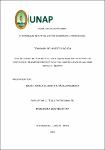| dc.contributor.advisor | Guerra Teixeira, Aldi Alida | |
| dc.contributor.author | Chávez Pizango, Paola Claudia | |
| dc.date.accessioned | 2018-11-16T16:12:14Z | |
| dc.date.available | 2018-11-16T16:12:14Z | |
| dc.date.issued | 2018 | |
| dc.identifier.uri | http://repositorio.unapiquitos.edu.pe/handle/20.500.12737/5649 | |
| dc.description.abstract | El siguiente trabajo se realizó con la finalidad de evaluar cómo influye la inclusión de la harina de flor de Marigold (Tagetes erecta) en raciones de gallinas ponedoras de la línea
Novogen Brown, en la que se utiliza al maíz amarillo como fuente principal de energía, y como pigmentante la harina de Marigold, evaluando el desempeño productivo y la calidad del huevo. En una población de 2000 gallinas de la línea Novogen Brown, de las cuales se extrajo una muestra de 288 gallinas de postura de esta línea, que representaron el total de la población, se distribuyeron completamente al azar en cuatro tratamientos y 4 repeticiones cada uno. Dónde T0 es el tratamiento control con 0 % de harina de flor de Marigold; T1 es el tratamiento con 0.1 % de harina de flor de Marigold, T2 es el tratamiento con 0.2 % de harina de flor de Marigold, y T3 es el tratamiento con 0.3 % de harina de flor de Marigold. El experimento se realizó en un periodo de 8 semanas, en edad de las aves desde la semana 26 a la semana 34, donde el agua se suministró ad libitum, mientras que para el alimento se siguieron las recomendaciones de alimentación de la línea Novogen. Se encontraron diferencias significativas (P>0,05) en el desempeño productivo, y en la pigmentación de la yema, mas no en las unidades Haugh ni en el tamaño de huevo de las gallinas que fueron alimentadas con harina de flor de Marigold (Tagetes erecta). Se encontró mejor beneficio económico con uno de los tratamientos donde se incluye a la harina de flor de Marigold (Tagetes erecta), como pigmentante natural. | es_PE |
| dc.description.abstract | The objective of this research was to evaluate the influence of the flour of Marigold’s
flower (Tagetes erecta) in rations for layings hens; breed Novogen Brown. In these rations
the main source of energy is the yellow corn, and the Marigold flour is used as a a
pigment. In this research we evaluated the production performance and the quality of the
egg.
From a barn of laying hens, with a population of 2000 hens, breed Novogen Brown, we
extracted a sample of 288 hens. What represented 14.40 % of the population. This sample
offered enough range to cover for any deviations. The sample was randomly selected. And
the treatment with the flour of Marigold’s flower (Tagetes erecta) was done four times and
4 repetitions each one.
Where T0 is the control treatment with 0 % marigold’s flower flour; T1 is the treatment
with 0.1 % marigold’s flower flour, T2 is the treatment with 0.2 % marigold’s flower flour,
and T3 is the treatment with 0.3 %.
The experiment was developed in a period of 8 weeks. The age of the birds was from the
26th to the 34th weeks. Water was supplied ad libitum, and for the feeding we followed
the recommendations of the line Novogen.
Significant differences (P> 0.05) were found in the productive performance, and in the
pigmentation of the yolk, but not in the Haug units or in the egg size of the hens that were
fed with Marigold flower flour (Tagetes erecta).
Therefore; in view of the results of the experiment, we could say that the use of the
marigold’s flower flour (Tagetes erecta), brings a couple of benefits: a) it is a natural
benign pigment (The flowers are carminitive, diuretic and vermifuge) and contain more
biologically useful compounds than previously believed * b) being a natural pigment
from an abundant flower, the treatment brings in the opportunity for economic benefits in
the poultry farming. | en_US |
| dc.description.uri | Trabajo de investigacion | es_PE |
| dc.format | application/pdf | es_PE |
| dc.language.iso | spa | es_PE |
| dc.publisher | Universidad de la Amazonía Peruana | es_PE |
| dc.rights | info:eu-repo/semantics/openAccess | es_PE |
| dc.rights | Attribution-NonCommercial-NoDerivs 3.0 United States | * |
| dc.rights.uri | http://creativecommons.org/licenses/by-nc-nd/3.0/us/ | * |
| dc.source | Universidad Nacional de la Amazonía Peruana | es_PE |
| dc.source | Repositorio institucional - UNAP | es_PE |
| dc.subject | Alimentos para animales | es_PE |
| dc.subject | Harinas de flor de marigold | es_PE |
| dc.subject | Tagetes erecta | es_PE |
| dc.subject | Raciones alimenticias | es_PE |
| dc.subject | Gallina ponedora | es_PE |
| dc.subject | Huevos | es_PE |
| dc.subject | Calidad | es_PE |
| dc.title | Uso de harina de flor de Marigold (Tagetes erecta) en la ración y su efecto en el desempeño productivo y calidad de huevo de gallinas Novogen Brown | es_PE |
| dc.type | info:eu-repo/semantics/bachelorThesis | es_PE |
| thesis.degree.discipline | Zootecnia | es_PE |
| thesis.degree.grantor | Universidad Nacional de la Amazonía Peruana. Facultad de Zootecnia | es_PE |
| thesis.degree.level | Título Profesional | es_PE |
| thesis.degree.name | Ingeniero Zootecnista | es_PE |
| thesis.degree.program | Regular | es_PE |
| dc.subject.ocde | Ciencias Animales y Lechería | es_PE |


